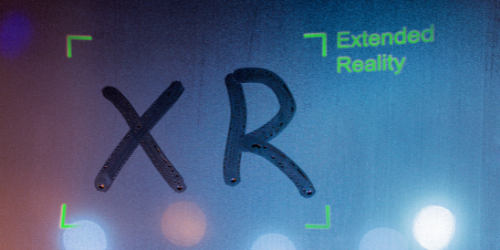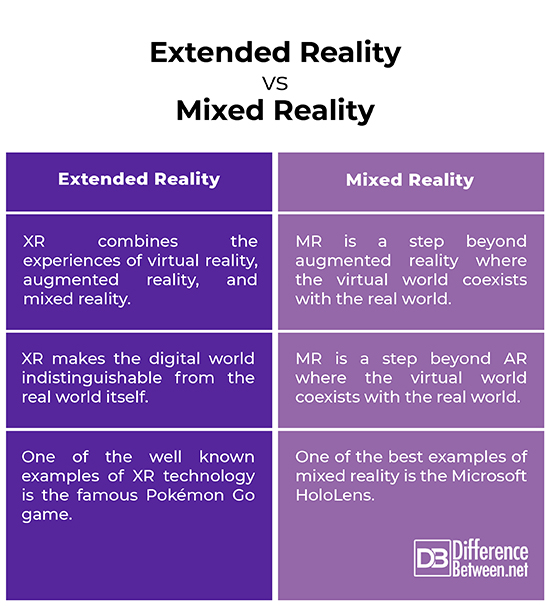Difference Between Extended Reality and Mixed Reality
Experimenting with realities is something we as humans have always loved to do. For the most part, technology has changed our point of view. The 90’s was the time of the virtual reality boom. More than two decades later, the technology got a reboot. The year 2019 was already a turning point, but the COVID-19 pandemic gave things the final push. And suddenly, the dream of extended reality would come true. But, with the emergence of so many similar technologies, our realities got mixed up.

What is an Extended Reality?
Extended Reality (XR) is an umbrella term that covers all the immersive technologies that extend the reality you experience by blending the virtual world and the physical world together. XR makes the digital world indistinguishable from the real world itself. XR refers to the real and virtual environments generated by computer technology and wearables to create more personalized, immersive experience. Progress of XR can be attributed to other key technology trends, including AI and cloud computing. The introduction of 5G networks will further fuel the evolution of XR by making XR hardware more faster, more responsive, and more portable.
XR is all about virtual reality, augmented reality and mixed reality, and all the new ways you can interact with technology. It is a different way of interacting with technology and with information – this is why it’s called extended reality. It is like exploring the imaginary worlds as if you’re actually there and share parts of those worlds in real life. One of the most well known examples of XR is the infamous Pokémon Go game that overlays virtual characters onto the real world, thereby enhancing the experience of reality by providing a life-like immersive experience.

What is Mixed Reality?
Mixed Reality (MR), sometimes referred to as hybrid reality, is a blend of physical and digital worlds, allowing you to interact with both the worlds. MR bridges the gap between the virtual world and the augmented world by superimposing an interactive experience over the physical world. MR is a step beyond augmented reality (AR) where the virtual world coexists with the real world. In mixed reality, you can navigate through the real world and a virtual environment seamlessly, and simultaneously.
Mixed Reality is one of the most recent innovations around extended reality where you are able to manipulate the digital images that are overlaid onto the real world. One of the best examples of mixed reality is the Microsoft HoloLens – a pair of mixed reality smartglasses that allows you to see the real world but you can also move and place objects in this real world. This is a holographic device that displays information and allows you to meddle with the real world or even simulate a virtual world.
Difference between Extended Reality and Mixed Reality
Technology
– Extended Reality (XR) is an all-encompassing term inclusive to all immersive technologies, virtual reality (VR), augmented reality (AR), and mixed reality (MR). XR refers to the real and virtual environments generated by computer technology and wearables to create more personalized, immersive experience. Mixed Reality (MR) is one of the most recent innovations around extended reality that bridges the gap between the virtual world and the augmented world by superimposing an interactive experience over the physical world.
Experience
– XR is like exploring the imaginary worlds as if you’re actually there and share parts of those worlds in real life. XR makes the digital world indistinguishable from the real world itself. It extends the reality you experience by blending the virtual world and the physical world together. MR, on the other hand, is hybrid reality that goes a step beyond augmented reality (AR) where the virtual world coexists with the real world. In MR, you can navigate through the real world and a virtual environment seamlessly, and simultaneously.
Example
– The video game industries are probably the foremost users of the XR technology. Pokémon Go game is probably the most well known example of extended reality those overlays virtual characters onto the real world. When it comes to mixed reality, a well-known example is the commercially available MR device, the Microsoft HoloLens, which is a head mounted device with lenses over your eyes that project holograms that you can interact with and manipulate. The HoloLens allows you to meddle with the real world or even simulate a virtual world.
Extended Reality vs. Mixed Reality: Comparison Chart

Summary
In a nutshell, XR combines the experience of all immersive technologies, including VR, AR and MR, and extend the reality you experience by blending the virtual world and the physical world together. XR makes your experience so real that you can hardly tell the real world from the virtual world. MR, on the other hand, combines the best aspects of VR and AR, and as the name suggests, it mixes virtual content or objects with the real word in an interactive, immersive way. In MR, virtual objects appear as natural as objects from the real world, which opens a new realm of experiences.
What is AR vs. XR?
AR is augmented reality which overlays computer generated content over the real world. AR is like an enhanced version of the physical world achieved through digital elements. XR is extended reality which combines the experience of all immersive technologies, including VR, AR and MR.
What’s the difference between AR, VR, and MR?
AR augments your reality by adding digital elements to the real world view; VR is just a computer-generated representation of a real or artificial world; and MR mixes virtual content or objects with the real word in an interactive, immersive way.
What does XR stand for reality?
XR stands for extended reality, which basically extends your experience by blending the virtual world and the physical world together.
What are the different types of XR?
XR is an umbrella term that combines the experiences of AR, VR and MR, and everything in between.
- Difference Between Caucus and Primary - June 18, 2024
- Difference Between PPO and POS - May 30, 2024
- Difference Between RFID and NFC - May 28, 2024
Search DifferenceBetween.net :
Leave a Response
References :
[0]Mealy, Paul. Virtual & Augmented Reality For Dummies. New Jersey, United States: John Wiley & Sons, 2018. Print
[1]Marr, Bernard. Extended Reality in Practice: 100+ Amazing Ways Virtual, Augmented and Mixed Reality Are Changing Business and Society. New Jersey, United States: John Wiley & Sons, 2021. Print
[2]Peddie, Jon. Augmented Reality: Where We Will All Live. Berlin, Germany: Springer, 2017. Print
[3]Image credit: https://www.canva.com/photos/MADvQvB6xKQ-the-word-xr-handwritten-by-finger-on-wet-window-glass-with-green-overlay-with-words-extended-reality-and-corner-frame/
[4]Image credit: https://www.canva.com/photos/MAEFmUPhyO4-mixed-reality/
